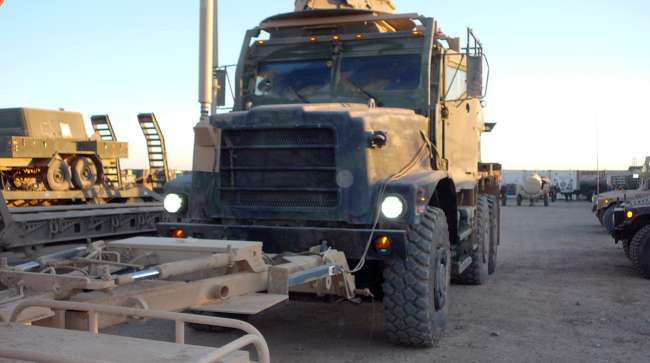LEDs Represent Future of Truck Headlamps

[Stay on top of transportation news: Get TTNews in your inbox.]
One of the biggest boosters for LED headlamps was Brad Van Riper, design chief at Truck-Lite, until his death a few years ago. The reason was the company engineered one of the first LED headlamps, and it was used in Humvees and other combat vehicles that were saving American servicemen’s lives. He had many testimonials from men and women in the battle zone who said they could see much better driving at night.
Those headlights, though, were prohibitively expensive for civilian applications a decade ago. But now, the technology has advanced, and the packaging and price of the white diodes has brought them nearly into the mainstream. Volvo, for instance, uses them as standard on the new VNL.
“The LED light offering has gained popularity as the technology has matured,” said John Felder, product marketing manager for Volvo Trucks North America. “It is now arguably the most significant lighting improvement in decades.”

Sturgess
Felder echoes Van Riper’s enthusiasm: “The light emitted from LEDs is better in color and brightness when compared to the alternatives. LEDs offer significant peripheral road clarity and increased forward visibility as well.”
The LED is the alternative to the long-established halogen-enhanced incandescent bulb and the more recent high-intensity discharge (HID) bulbs that have seen some uptake by truck manufacturers.
The popularity of HID was due to the intense white light of the hot arc that is the light source in this bulb. HIDs are more expensive to produce and far more complex than halogen lighting as they need added electronics to start and then maintain the arc with an AC current.
Paul Menig, the principal of consulting company Tech-I-M and past chief engineer of mechatronics with Daimler Trucks of North America, agrees that HID is something of an interim technology as LED headlamps have improved in lighting efficiency at lower cost.
“LEDs are likely cheaper than HID, and they definitely last longer,” Menig said.
And more is to come: “I fully expect all the electric vehicle offerings to use LED to save energy and weight,” he said.
Frank Trzaska, director of maintenance support for Camden, N.J.-based carrier NFI, agrees.
“HID has its place, but the LED technology is now maturing and becoming more readily available at a reasonable cost,” he said. “Reflector technology along with heat sinks are being made to fit a certain size package cost effectively. Prices are coming down as they penetrate the market deeper as standard equipment. They last longer than we keep the trucks.”
However, the importance of balancing the design of the performance of the LED with the size and type of heat sink and the quality of the wiring is critical.

- Preparing New Technicians for Service
- Electronic Braking Systems Expected to Gain Traction
- Suppliers Invest in Industry's Future Despite Market Slowdown
- Technician Career Development: An Endless Journey
- LEDs Represent Future of Truck Headlamps
- Rear-Axle Ratios Are Still Moving Downward
- Tractor-Trailers at a Tipping Point
A fascinating YouTube video pre- sented by website Headlight Revolution points out that by no means are all LED headlamp bulbs created equal.
If they are a balanced design, investment in the right LED lighting will likely pay off in the long run.
“On an incandescent system, we would typically replace two to three bulbs a year per side,” NFI’s Trzaska said. “The roads in the Northeast are notoriously poor, littered with potholes and frost heaves. Road shock failure is a large concern.”
Cost is a factor, but driver safety and inspection infractions are more important, he said.
“My assumption is [LEDs] would cut down on incidents and accidents, as well as animal strikes and minor incidents in yards. I don’t have any hard data to quote you with, but from my own experience, it seems like a natural event reduction from the light quality,” Trzaska said.
LED forward lighting is definitely the future of the headlamp, Volvo’s Felder said.
“LED lamps will outlive the other technologies tenfold,” he said, “and the unnoticed part of this interesting story is the LED lighting uses considerably less energy. There is always a trade-off with new technology, and in the case of LEDs, light efficiency means the energy is concentrated on the light itself.”
And this means less demand on the electrical system, Menig said.
“The diodes in the LED lamps operate at lower voltages than any voltage coming out of the alternator or battery, whether it is 12, 24 or higher,” he said. “That means there has to be electronics somewhere to bring the voltage down. Think about all the bright LED flashlights we have that operate on one to four alkaline batteries. That’s less than 1.5 volts in many cases.”
Want more news? Listen to today's daily briefing:

